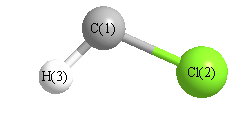Jump to
S2C1
Energy calculated at B1B95/3-21G*
| | hartrees |
|---|
| Energy at 0K | -496.470993 |
| Energy at 298.15K | -496.470824 |
| HF Energy | -496.470993 |
| Nuclear repulsion energy | 37.832307 |
The energy at 298.15K was derived from the energy at 0K
and an integrated heat capacity that used the calculated vibrational frequencies.
Geometric Data calculated at B1B95/3-21G*
Point Group is Cs
Cartesians (Å)
| Atom |
x (Å) |
y (Å) |
z (Å) |
|---|
| C1 |
0.046 |
1.223 |
0.000 |
| Cl2 |
0.046 |
-0.517 |
0.000 |
| H3 |
-1.058 |
1.446 |
0.000 |
Atom - Atom Distances (Å)
| |
C1 |
Cl2 |
H3 |
| C1 | | 1.7401 | 1.1261 |
Cl2 | 1.7401 | | 2.2522 | H3 | 1.1261 | 2.2522 | |
 More geometry information
More geometry information
Calculated Bond Angles
| atom1 |
atom2 |
atom3 |
angle |
|
atom1 |
atom2 |
atom3 |
angle |
| Cl2 |
C1 |
H3 |
101.423 |
|
Electronic energy levels
Charges, Dipole, Quadrupole and Polarizability
Charges from optimized geometry at B1B95/3-21G*
Charges (e)
| Number |
Element |
Mulliken |
CHELPG |
AIM |
ESP |
| 1 |
C |
-0.242 |
|
|
|
| 2 |
Cl |
0.040 |
|
|
|
| 3 |
H |
0.202 |
|
|
|
Electric dipole moments
Electric dipole components in Debye
(What's a Debye? See section
VII.A.3)
| |
x |
y |
z |
Total |
| |
-1.626 |
-0.417 |
0.000 |
1.679 |
| CHELPG |
|
|
|
|
| AIM |
|
|
|
|
| ESP |
|
|
|
|
Electric Quadrupole moment
Quadrupole components in D Å
| Primitive |
|---|
| | x | y | z |
|---|
| x |
-19.559 |
-2.697 |
0.000 |
| y |
-2.697 |
-20.110 |
0.000 |
| z |
0.000 |
0.000 |
-18.050 |
|
| Traceless |
|---|
| | x | y | z |
|---|
| x |
-0.479 |
-2.697 |
0.000 |
| y |
-2.697 |
-1.305 |
0.000 |
| z |
0.000 |
0.000 |
1.784 |
|
| Polar |
|---|
| 3z2-r2 | 3.568 |
|---|
| x2-y2 | 0.551 |
|---|
| xy | -2.697 |
|---|
| xz | 0.000 |
|---|
| yz | 0.000 |
|---|
|
Polarizabilities
Components of the polarizability tensor.
Units are
Å
3 (Angstrom cubed)
Change units.
| |
x |
y |
z |
| x |
2.241 |
-0.415 |
0.000 |
| y |
-0.415 |
4.553 |
0.000 |
| z |
0.000 |
0.000 |
1.753 |
<r2> (average value of r
2) Å
2
| <r2> |
28.796 |
| (<r2>)1/2 |
5.366 |
Jump to
S1C1
Energy calculated at B1B95/3-21G*
| | hartrees |
|---|
| Energy at 0K | -496.475237 |
| Energy at 298.15K | -496.475080 |
| HF Energy | -496.475237 |
| Nuclear repulsion energy | 38.849041 |
The energy at 298.15K was derived from the energy at 0K
and an integrated heat capacity that used the calculated vibrational frequencies.
Geometric Data calculated at B1B95/3-21G*
Point Group is Cs
Cartesians (Å)
| Atom |
x (Å) |
y (Å) |
z (Å) |
|---|
| C1 |
0.036 |
1.158 |
0.000 |
| Cl2 |
0.036 |
-0.514 |
0.000 |
| H3 |
-0.838 |
1.798 |
0.000 |
Atom - Atom Distances (Å)
| |
C1 |
Cl2 |
H3 |
| C1 | | 1.6720 | 1.0842 |
Cl2 | 1.6720 | | 2.4724 | H3 | 1.0842 | 2.4724 | |
 More geometry information
More geometry information
Calculated Bond Angles
| atom1 |
atom2 |
atom3 |
angle |
|
atom1 |
atom2 |
atom3 |
angle |
| Cl2 |
C1 |
H3 |
126.201 |
|
Electronic energy levels
Charges, Dipole, Quadrupole and Polarizability
Charges from optimized geometry at B1B95/3-21G*
Charges (e)
| Number |
Element |
Mulliken |
CHELPG |
AIM |
ESP |
| 1 |
C |
-0.305 |
|
|
|
| 2 |
Cl |
0.060 |
|
|
|
| 3 |
H |
0.245 |
|
|
|
Electric dipole moments
Electric dipole components in Debye
(What's a Debye? See section
VII.A.3)
| |
x |
y |
z |
Total |
| |
-0.879 |
0.408 |
0.000 |
0.969 |
| CHELPG |
|
|
|
|
| AIM |
|
|
|
|
| ESP |
|
|
|
|
Electric Quadrupole moment
Quadrupole components in D Å
| Primitive |
|---|
| | x | y | z |
|---|
| x |
-18.349 |
-1.618 |
0.000 |
| y |
-1.618 |
-17.024 |
0.000 |
| z |
0.000 |
0.000 |
-19.493 |
|
| Traceless |
|---|
| | x | y | z |
|---|
| x |
-0.091 |
-1.618 |
0.000 |
| y |
-1.618 |
1.897 |
0.000 |
| z |
0.000 |
0.000 |
-1.807 |
|
| Polar |
|---|
| 3z2-r2 | -3.614 |
|---|
| x2-y2 | -1.325 |
|---|
| xy | -1.618 |
|---|
| xz | 0.000 |
|---|
| yz | 0.000 |
|---|
|
Polarizabilities
Components of the polarizability tensor.
Units are
Å
3 (Angstrom cubed)
Change units.
| |
x |
y |
z |
| x |
1.706 |
-0.237 |
0.000 |
| y |
-0.237 |
4.090 |
0.000 |
| z |
0.000 |
0.000 |
1.270 |
<r2> (average value of r
2) Å
2
| <r2> |
27.928 |
| (<r2>)1/2 |
5.285 |
